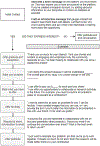Engaging Social Media Influencers to Recruit Hard-to-Reach Populations
- PMID: 34334700
- PMCID: PMC8563382
- DOI: 10.1097/NNR.0000000000000544
Engaging Social Media Influencers to Recruit Hard-to-Reach Populations
Abstract
Background: Though clinical researchers have begun to use social media platforms to recruit participants, social media influencers are innovative community connectors to further expand recruitment reach, especially in hard-to-reach populations.
Objectives: The purpose of this methods article is to provide a step-by-step guide for engaging social media influencers for virtual participant recruitment.
Methods: There are multiple steps for researchers to follow, including preplanning, institutional review board approval, engaging with influencers, the pitch, the post, and results dissemination.
Discussion: Engaging social media influencers to recruit for clinical research demonstrates great potential to increase access to hard-to-reach populations. Several methodological considerations remain, and this article shares both opportunities and challenges to guide researchers in this technique.
Copyright © 2021 Wolters Kluwer Health, Inc. All rights reserved.
Conflict of interest statement
The authors have no conflicts of interest to report.
Figures
References
-
- Bender JL, Cyr AB, Arbuckle L, & Ferris LE (2017). Ethics and privacy implications of using the internet and social media to recruit participants for health research: A privacy-by-design framework for online recruitment. Journal of Medical Internet Research, 19(4), e104–e104. 10.2196/jmir.7029 - DOI - PMC - PubMed
-
- Caretta MA (2016). Member checking: A feminist participatory analysis of the use of preliminary results pamphlets in cross-cultural, cross-language research. Qualitative Research, 16(3), 305–318. 10.1177/1468794115606495 - DOI
Publication types
MeSH terms
Grants and funding
LinkOut - more resources
Full Text Sources
Medical


